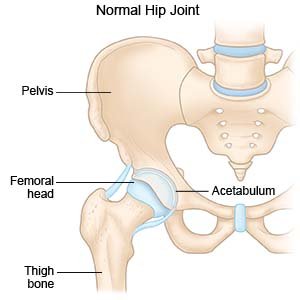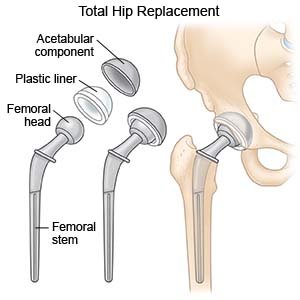Total Hip Replacement
Medically reviewed by Drugs.com. Last updated on Aug 4, 2025.
What do I need to know about total hip replacement (THR)?
THR, or total hip arthroplasty, is surgery to replace all or part of your hip joint. The hip joint is where the top of your femur (thigh bone) sits in the socket of your pelvic bone. The joint is held together by ligaments and muscles. The top of your femur is shaped like a ball and covered with cartilage. Cartilage is a tissue that helps joints move.
 |
How do I prepare for THR?
- Your surgeon will tell you how to prepare. Your surgeon may tell you not to eat or drink anything after midnight on the day of your surgery. Arrange to have someone drive you home when you are discharged.
- Tell your surgeon about all medicines you currently take. Your surgeon will tell you if you need to stop any medicine for the surgery, and when to stop. Your surgeon will tell you which medicines to take or not take on the day of surgery.
- Tell your surgeon about any allergies you have, including anesthesia or medicines. You may be given an antibiotic to help prevent a bacterial infection.
- Your surgeon will tell you if you need any tests before your surgery, and when to have them.
- You may need blood and urine tests before your surgery. These tests show how well your kidneys are functioning and your blood is clotting. You may also need x-rays or an ultrasound.
Related medications
What will happen during THR?
- You may be given general anesthesia to keep you asleep and free from pain during surgery. You may instead be given spinal, or regional, anesthesia. This type will numb you from the waist down. You may still feel pressure or pushing, but you should not feel any pain.
- Your surgeon will make an incision over your hip. The top, or head, of the femur will be removed and a metal stem will be placed into the middle of your leg bone. A metal or ceramic ball will be placed on the upper part of the stem. This ball replaces the damaged bone that was removed.
- The damaged cartilage of your hip socket will be removed and replaced with a metal socket or porous surface. The porous surface allows your bone to grow and fill the pores of the implant. Medical cement or screws may be placed to secure the implant parts. A metal, ceramic, or plastic spacer will be placed between the ball and socket. This creates a smooth surface for the parts to move smoothly against each other.
- The incision will be closed with stitches or staples. You may have a bandage covering the area.
 |
What should I expect after THR?
You may have increased pain or stiffness after surgery. This will get better with movement and exercise. Providers will teach you how to sit up and move without damaging your hip. A physical therapist will help you get up and walk after surgery. You may need a walker.
What are the risks of THR?
You may bleed more than expected or develop an infection. One leg may feel longer or shorter than the other. Your nerves, blood vessels, ligaments, or muscles may be damaged during surgery. Your implant may become loose or move out of place. If this happens, you may need another surgery to replace the implant. You may get a blood clot in your limb. This may become life-threatening.
Care Agreement
You have the right to help plan your care. Learn about your health condition and how it may be treated. Discuss treatment options with your healthcare providers to decide what care you want to receive. You always have the right to refuse treatment. The above information is an educational aid only. It is not intended as medical advice for individual conditions or treatments. Talk to your doctor, nurse or pharmacist before following any medical regimen to see if it is safe and effective for you.© Copyright Merative 2025 Information is for End User's use only and may not be sold, redistributed or otherwise used for commercial purposes.
Learn more about Total Hip Replacement
Treatment options
Care guides
Further information
Always consult your healthcare provider to ensure the information displayed on this page applies to your personal circumstances.
